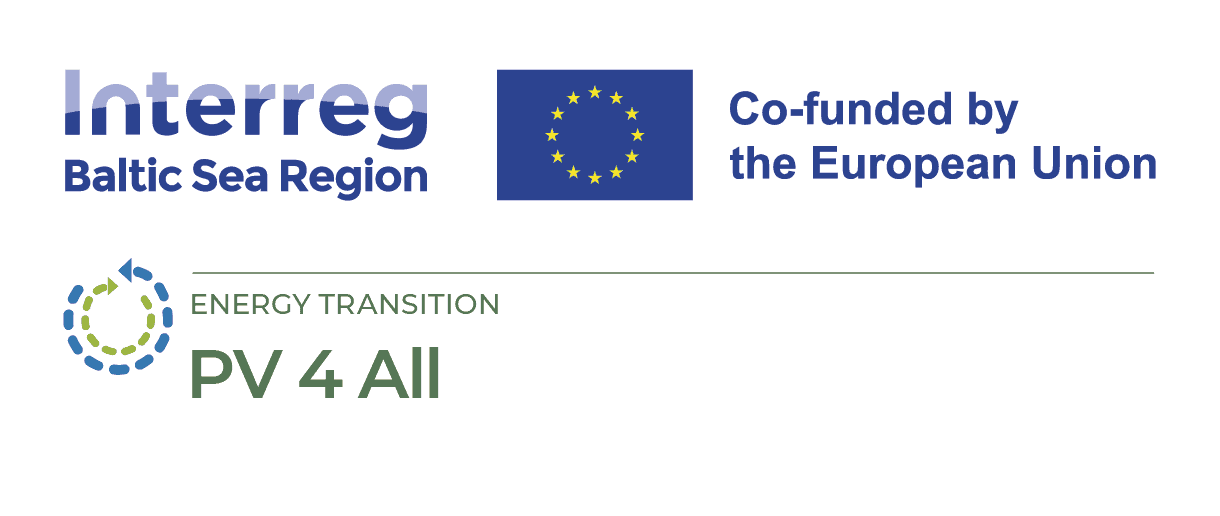
PV4All: Tailored solutions drive solar adoption across Baltic Sea Region
11 November 2024
Starting Situation: A Shared Vision with Unique Challenges
PV4All was launched as a collaborative initiative involving six partners from five different European countries, each facing distinct challenges in promoting photovoltaic (PV) energy. Despite varying regional landscapes and regulatory environments, all partners shared a common goal: to expand PV energy adoption. However, each country’s specific social, economic, legislative and geographic circumstances influenced how easily PV energy could be integrated. From urban tenants without roof access to rural farmers with substantial land constraints, the diversity of issues presented a significant challenge. As each partner sought to empower their communities to use more renewable energy, it became clear that a one-size-fits-all approach would not be sufficient.
Our Approach: Tailoring Solutions for Real Impact
Recognizing the diversity of issues and opportunities across countries and regions, PV4All tried to adopt a flexible, customized approach tailored to specific local circumstances. From the beginning, the team prioritized understanding where PV4All could make the most impact. This meant an initial phase of research and needs assessment in each partner’s region. Through collaborative discussions and on-the-ground observations, the partners identified key obstacles to PV adoption and pinpointed potential areas of influence. This groundwork allowed PV4All to develop solutions that were as adaptable as the communities they were designed to serve.
Milestones Achieved
- Creating the PV4All Atlas
PV4All’s first major achievement was compiling a comprehensive overview of PV energy circumstances across participating regions, known as the PV4All Atlas. This resource gathered essential data on PV energy potential, market dynamics, regulatory landscapes, and barriers specific to each area. The Atlas provided a data-driven foundation, helping each partner understand not only the challenges but also the opportunities available within their regions. - Target Group Identification
Analysis from the Atlas guided PV4All partners toward identifying specific target groups that would benefit the most from tailored PV solutions. A key focus emerged on three distinct groups: private persons (like urban tenants or houseowners in the landscape), private institutions (e.g. large housing enterprises) and public institutions (municipalities, local & regional administrations), which had significant potential for PV integration but faced barriers. Additionally, farmers in select rural areas were recognized as an important group, particularly those whose energy-intensive operations could benefit from local PV installations. By addressing the needs of these groups, PV4All aimed to make PV energy accessible to a wider range of people. - Toolbox Development for Actionable Outreach
With target groups in focus, the project developed a PV4All Toolbox containing practical strategies and materials to help partners engage these communities. The Toolbox includes:- Digital Seminars and On-Site Events: Offering free online and live seminars to educate for example representatives of public institutions, private persons or farmers about PV benefits, costs, and installation processes.
- Exhibitions and Demonstrations: Hosting PV demonstrations and exhibitions to allow community members to experience the technology firsthand.
- Free Consultations: Providing direct consultations to help stakeholders assess their PV potential, learn about financial support options, and get started with PV integration.
- Guidelines and Step-by-Step Action Plans: Creating clear, easy-to-follow guides that outline the process from planning to installation, tailored for each target group.
- Idea Evaluation and Testing for Real-World Impact
To ensure these tools would be effective, PV4All entered an iterative phase of evaluation and testing. Initial ideas were assessed against real-world constraints and potential impact. Promising tools, such as interactive digital seminars for public administration and personalized on-site consultations for farmers, were tested in pilot sessions to gather feedback and refine the approach. This testing process allowed partners to see which strategies resonated most and to adjust their outreach and support efforts for optimal impact.
Main Achievements Across Regions
A big success within the project was the transnational cooperation of the partners from the Baltic Sea. The project was characterized by determined cooperation across the various work priorities and milestones. We found it crucial to find our own tailor-made goals and ideas depending on the profile of the respective partner and to benefit from the ideas and expertise of the other partners in this process. This resulted in the key achievements.
- Lithuania: A significant policy change now permits the installation of balcony power plants, enabling residents in urban areas to produce their own energy and reduce pressure on the national grid. This breakthrough allows even those without traditional roof access to adopt PV technology and contribute to a sustainable energy future.
- Finland: PV4All developed a solar calculator, a crucial tool for assessing PV potential in various regions of the country. While common in other countries, this was the first tool of its kind in Finland, and it now provides Finnish residents with valuable insights into the viability of PV systems in their areas, empowering them to make informed energy choices.
- Germany: PV4All successfully tested different approaches to engage a new, previously overlooked demographic: socially disadvantaged individuals. Traditionally, this group had not viewed PV energy as relevant to their lives. By tailoring outreach efforts, PV4All connected with numerous individuals, broadening awareness and inclusivity within the PV energy movement.
- Sweden: The project initiated a dialogue on the potential of Agri PV, a model combining agriculture with PV installation by placing PV modules above crops, thereby producing electricity and cultivating crops simultaneously. This concept, still emerging, has the potential to revolutionize land use in Sweden, making it possible for farmers to diversify income sources while contributing to renewable energy goals.
- Poland: Similar to Sweden, PV4All promoted Agri PV, which has sparked considerable interest. Polish farmers, recognizing the dual benefits of generating green energy and securing an additional income stream, have shown strong enthusiasm. This approach could leverage Poland’s substantial agricultural sector for a dual-purpose energy and food production model.
Moving Forward: A Future Built on Flexible, Impactful Solutions
With its combination of data-driven insight, region-specific tools, and tailored outreach, PV4All has laid the groundwork for lasting change in PV adoption. By recognizing the unique needs of each partner country and directly addressing them, the project has expanded the reach and relevance of PV energy in meaningful ways.





